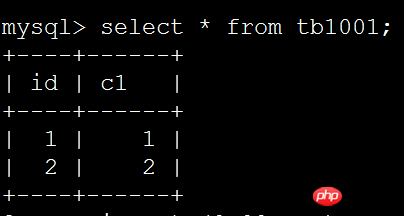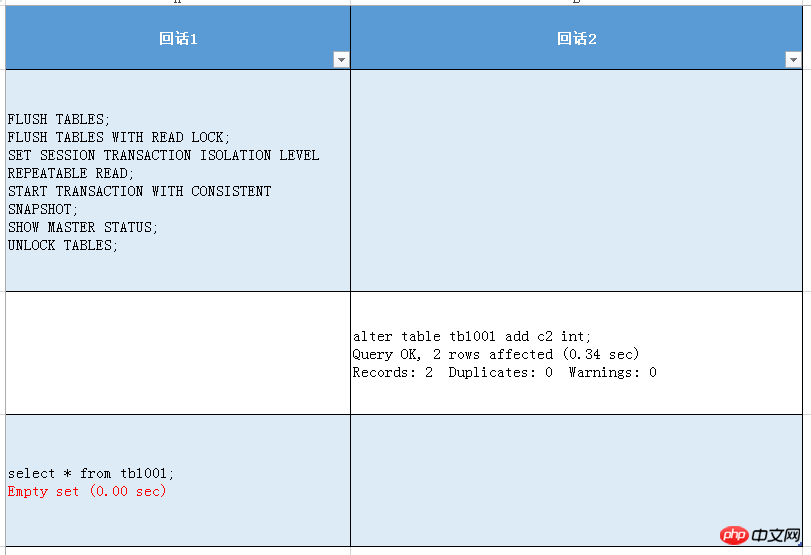 Database
Database
 Mysql Tutorial
Mysql Tutorial
 What should I do when mysqldump --single-transaction encounters alter table?
What should I do when mysqldump --single-transaction encounters alter table?
What should I do when mysqldump --single-transaction encounters alter table?
Test environment:
MySQL 5.5.14
There is table tb1001 under database testdb01, and there are two pieces of data in the current table:

##============================================ ================

##It was found that an empty set was returned without any error.
This also reasonably explains the phenomenon of my colleague's operation: during the mysqldump process, the table structure was modified, the modification operation was not blocked, and the mysqldump operation was "completed normally".
Since the SELECT /*!40001 SQL_NO_CACHE */ * FROM `tb1001` operation does not return an error or data, the mysqldump process will treat tb1001 as an empty table, and then continue to export subsequent tables until all are exported. The table then returns a status of successful execution. However, the exported backup already lacks the data of tb1001. If you happen to use this backup to restore data, it will inevitably lead to "data loss".
Solution:
Before modifying the table on MySQL 5.5 version, first check whether the current server is performing a mysqldump operation to avoid parallel execution of the two.
If you modify a table that has been exported by mysqldump, the modification operation will be blocked until mysqldump ends. This situation is consistent with MySQL version 5.6.
Summary:
For MySQL version 5.5, mysqldump is executed at the same time as the table modification operation:
If the table modification operation is after "mysqldump is turned on but the modification has not been exported" Starting within the time period " before the table data, the modifying table operation is completed successfully, and mysqldump will not fail to execute, but the data of the modified table cannot be exported normally;
If the modifying table operation is performed in "mysqldum has exported the modified table data but not yet completed the mysqldump operation" time period, the table modification operation is blocked, mysqldum can be completed successfully, and the table modification operation can be executed normally after the mysqldump operation is completed.
For MySQL version 5.5, you should avoid performing mysqldump and modify table operations at the same time to avoid losing the data of the modified table in the backup and causing data inconsistency!
The above is the detailed content of What should I do when mysqldump --single-transaction encounters alter table?. For more information, please follow other related articles on the PHP Chinese website!

Hot AI Tools

Undresser.AI Undress
AI-powered app for creating realistic nude photos

AI Clothes Remover
Online AI tool for removing clothes from photos.

Undress AI Tool
Undress images for free

Clothoff.io
AI clothes remover

AI Hentai Generator
Generate AI Hentai for free.

Hot Article

Hot Tools

Notepad++7.3.1
Easy-to-use and free code editor

SublimeText3 Chinese version
Chinese version, very easy to use

Zend Studio 13.0.1
Powerful PHP integrated development environment

Dreamweaver CS6
Visual web development tools

SublimeText3 Mac version
God-level code editing software (SublimeText3)

Hot Topics
 1376
1376
 52
52
 How do you alter a table in MySQL using the ALTER TABLE statement?
Mar 19, 2025 pm 03:51 PM
How do you alter a table in MySQL using the ALTER TABLE statement?
Mar 19, 2025 pm 03:51 PM
The article discusses using MySQL's ALTER TABLE statement to modify tables, including adding/dropping columns, renaming tables/columns, and changing column data types.
 How do I configure SSL/TLS encryption for MySQL connections?
Mar 18, 2025 pm 12:01 PM
How do I configure SSL/TLS encryption for MySQL connections?
Mar 18, 2025 pm 12:01 PM
Article discusses configuring SSL/TLS encryption for MySQL, including certificate generation and verification. Main issue is using self-signed certificates' security implications.[Character count: 159]
 How do you handle large datasets in MySQL?
Mar 21, 2025 pm 12:15 PM
How do you handle large datasets in MySQL?
Mar 21, 2025 pm 12:15 PM
Article discusses strategies for handling large datasets in MySQL, including partitioning, sharding, indexing, and query optimization.
 What are some popular MySQL GUI tools (e.g., MySQL Workbench, phpMyAdmin)?
Mar 21, 2025 pm 06:28 PM
What are some popular MySQL GUI tools (e.g., MySQL Workbench, phpMyAdmin)?
Mar 21, 2025 pm 06:28 PM
Article discusses popular MySQL GUI tools like MySQL Workbench and phpMyAdmin, comparing their features and suitability for beginners and advanced users.[159 characters]
 How do you drop a table in MySQL using the DROP TABLE statement?
Mar 19, 2025 pm 03:52 PM
How do you drop a table in MySQL using the DROP TABLE statement?
Mar 19, 2025 pm 03:52 PM
The article discusses dropping tables in MySQL using the DROP TABLE statement, emphasizing precautions and risks. It highlights that the action is irreversible without backups, detailing recovery methods and potential production environment hazards.
 Explain InnoDB Full-Text Search capabilities.
Apr 02, 2025 pm 06:09 PM
Explain InnoDB Full-Text Search capabilities.
Apr 02, 2025 pm 06:09 PM
InnoDB's full-text search capabilities are very powerful, which can significantly improve database query efficiency and ability to process large amounts of text data. 1) InnoDB implements full-text search through inverted indexing, supporting basic and advanced search queries. 2) Use MATCH and AGAINST keywords to search, support Boolean mode and phrase search. 3) Optimization methods include using word segmentation technology, periodic rebuilding of indexes and adjusting cache size to improve performance and accuracy.
 How do you represent relationships using foreign keys?
Mar 19, 2025 pm 03:48 PM
How do you represent relationships using foreign keys?
Mar 19, 2025 pm 03:48 PM
Article discusses using foreign keys to represent relationships in databases, focusing on best practices, data integrity, and common pitfalls to avoid.
 How do you create indexes on JSON columns?
Mar 21, 2025 pm 12:13 PM
How do you create indexes on JSON columns?
Mar 21, 2025 pm 12:13 PM
The article discusses creating indexes on JSON columns in various databases like PostgreSQL, MySQL, and MongoDB to enhance query performance. It explains the syntax and benefits of indexing specific JSON paths, and lists supported database systems.



